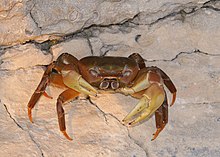Cardisoma
Appearance
| Cardisoma | |
|---|---|

| |
| Cardisoma carnifex | |
| Scientific classification | |
| Domain: | Eukaryota |
| Kingdom: | Animalia |
| Phylum: | Arthropoda |
| Class: | Malacostraca |
| Order: | Decapoda |
| Suborder: | Pleocyemata |
| Infraorder: | Brachyura |
| Family: | Gecarcinidae |
| Genus: | Cardisoma Latreille, 1828 |
| Type species | |
| Cardisoma guanhumi Latreille, 1828
| |
Cardisoma is a genus of large land crabs. Three species formerly placed in this genus are now placed in Discoplax.[1] The four species that remain in Cardisoma are found in warm coastal regions where they live in burrows. Young individuals are often very colourful with a purple-blue carapace and orange-red legs (leading to a level of popularity in the pet trade), but as they grow older the colours tend to fade, and females may be duller than males. Although less extreme than in fiddler crabs, one claw is usually considerably larger than the other.[2] They are omnivores, but primarily feed on plant material.[3]
Species
[edit]The genus Cardisoma comprises these four species:[1]
| Image | Name | Common name | Distribution |
|---|---|---|---|
 |
Cardisoma armatum Herklots, 1851 | (African) rainbow crab, (Nigerian) moon crab or patriot crab | east Atlantic coastal regions |
 |
Cardisoma carnifex (Herbst, 1794) | red-claw crab | Indo-Pacific coastal regions |
 |
Cardisoma crassum Smith, 1870 | mouthless crab | east Pacific coastal regions |
 |
Cardisoma guanhumi Latreille, 1825 | blue land crab or giant land crab | west Atlantic coastal regions |
See also
[edit]- Tuerkayana – a genus which holds crabs formerly found in Discoplax and Cardisoma[4]
References
[edit]- ^ a b Peter K. L. Ng; Danièle Guinot & Peter J. F. Davie (2008). "Systema Brachyurorum: Part I. An annotated checklist of extant Brachyuran crabs of the world" (PDF). Raffles Bulletin of Zoology. 17: 1–286. Archived from the original (PDF) on 2011-06-06.
- ^ Mariappan, Pitchaimuthu; Balasundaram, Chellam; Schmitz, Barbara (September 2000). "Decapod crustacean chelipeds: an overview". Journal of Biosciences. 25 (3). Indian Academy of Sciences: 301–313. doi:10.1007/BF02703939. ISSN 0250-5991. PMID 11022233. S2CID 21474481.
- ^ Donald B. Bright & Charles L. Hogue (1972). "A synopsis of burrowing land crabs of the world and list of their arthropod symbionts and burrow associates" (PDF). Contributions in Science. 220: 1–58. doi:10.5962/p.241205. S2CID 92490593. Archived from the original (PDF) on 2010-10-09.
- ^ Guinot, Danièle; Ng, Ngan Kee; Rodríguez Moreno, Paula A. (21 December 2018). "Review of grapsoid families for the establishment of a new family for Leptograpsodes Montgomery, 1931, and a new genus of Gecarcinidae H. Milne Edwards, 1837 (Crustacea, Decapoda, Brachyura, Grapsoidea MacLeay, 1838)" (PDF). Zoosystema. 40 (sp1): 547–604. doi:10.5252/zoosystema2018v40a26. S2CID 92671389. Archived from the original (PDF) on 14 February 2019.


